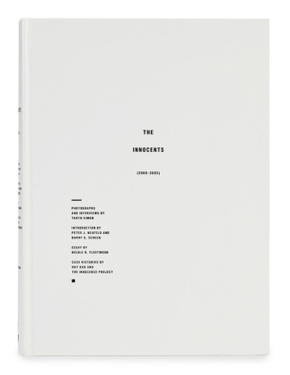Taryn Simon - The Innocents
| Verlag | Hatje Cantz Verlag |
| Auflage | 2022 |
| Seiten | 440 |
| Format | 25,8 x 4,0 x 34,4 cm |
| Gewicht | 3258 g |
| Artikeltyp | Englisches Buch |
| ISBN-10 | 3775746285 |
| EAN | 9783775746281 |
| Bestell-Nr | 77574628A |
New volume in the series of outstanding artists' books Content concerning unjust incarceration in the United States First exhibited at MoMA PS1
New volume in the series of outstanding artists' books Content concerning unjust incarceration in the United States First exhibited at MoMA PS1
Taryn Simon's earliest body of work, The Innocents (2003), documents stories of individuals who were incarcerated for violent crimes they did not commit. The project stands as a photographic record of some of the earliest DNA-based exonerations in the United States and as a searing indictment of America's criminal legal system.
The Innocents interrogates photography's credibility as an arbiter of justice. People suspected of committing crimes are identified through photographs and lineups, a procedure that relies on the assumption of precise visual memory. But through exposure to composite sketches, mug shots, Polaroids, and lineups, eyewitness memory can change. In the cases in this book, photography aided in convicting and imprisoning people for crimes they did not commit. The Innocents compiles Simon's photographs of forty-six individuals at sites that had particular significance to their convictions: the scene of the crime, misidentification, arrest, or alibi.
< br>This expanded edition includes previously unpublished images; a new introduction by Innocence Project co-founders Peter J. Neufeld and Barry C. Scheck; a new essay by professor and curator Nicole R. Fleetwood based on a conversation with criminal legal and social justice activist Tyra Patterson; as well as police reports, court transcripts, and correspondence detailing the procedures behind many of the misidentifications and wrongful convictions in this book.
TARYN SIMON (_1975, New York) directs our attention to familiar systems of organization-bloodlines, circulating picture collections, mourning rituals, ceremonial flower arrangements-making visible the contours of power and authority hidden within them. Incorporating mediums ranging from photography and sculpture to text, sound, and performance, her works are informed by research on and with institutions including the U.S. Department of Homeland Security, the Central Zionist Archives, the International Commission on Missing Persons, Smith & Wesson, The Walt Disney Company, and the Fine Arts Commission of the CIA.

